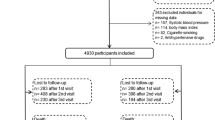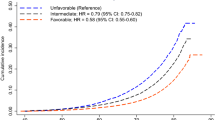Abstract
The effects of interventions on multiple lifestyle and metabolic risk factors, initiated in midlife or later in a healthy population, on the long-term risk of first-ever stroke is not known. A particular methodological challenge in observational studies is to estimate the unbiased effect of a time-varying exposure in presence of time-varying confounders, if those confounders are affected by prior exposure. In such cases, the parametric g-formula can be applied to estimate an unbiased effect. We applied the parametric g-formula to estimate the 18-years (1994–2012) cumulative stroke risk under different scenarios of hypothetical interventions on levels of blood pressure, cholesterol, weight, physical activity, smoking and alcohol intake; and compared these to the observed scenario, to calculate the population risk ratios and risk differences. Among 14,796 eligible participants in the prospective, population-based Tromsø study (baseline mean age 46.1 years, 51% women), the observed 18-years stroke risk was 5.9%. A feasible joint hypothetical intervention on six lifestyle and metabolic risk factors would reduce the 18-year stroke risk by 32% (95% confidence interval 16, 44). A combination of more intensive interventions reduced the estimated 18-years stroke risk by 64% (95% confidence interval 40, 80). Blood pressure reduction and quitting smoking significantly reduced the risk when applied separately.

Similar content being viewed by others
References
Feigin VL, Krishnamurthi RV, Parmar P, Norrving B, Mensah GA, Bennett DA, et al. Update on the Global Burden of Ischemic and Hemorrhagic Stroke in 1990–2013: The GBD 2013 Study. Neuroepidemiology. 2015;45:161–76.
Kissela BM, Khoury JC, Alwell K, Moomaw CJ, Woo D, Adeoye O, et al. Age at stroke: temporal trends in stroke incidence in a large, biracial population. Neurology. 2012;79:1781–7.
Benjamin EJ, Blaha MJ, Chiuve SE, et al. heart disease and stroke statistics-2017 update: a report from the American Heart Association. Circulation. 2017;135(10):e46–603.
Ezzati M, Hoorn SV, Rodgers A, Lopez AD, Mathers CD, Murray CJL, et al. Estimates of global and regional potential health gains from reducing multiple major risk factors. Lancet. 2003;362:271–80.
Neal B, MacMahon S, Chapman N, Blood Pressure Lowering Treatment Trialists’ Collaboration. Blood pressure lowering treatment trialists’ collaboration. effects of ACE inhibitors, calcium antagonists, and other blood-pressure-lowering drugs: results of prospectively designed overviews of randomised trials. Blood Pressure Lowering Treatment Trialists’ Collaboration. Lancet. 2000;356:1955–64.
Chobanian AV, Bakris GL, Black HR, Cushman WC, Green LA, Izzo JL, et al. Seventh report of the Joint National Committee on Prevention, Detection, Evaluation, and Treatment of High Blood Pressure. Hypertension. 2003;42:1206–52.
Lewington S, Clarke R, Qizilbash N, Peto R, Collins R, Prospective Studies Collaboration. Age-specific relevance of usual blood pressure to vascular mortality: a meta-analysis of individual data for one million adults in 61 prospective studies. Lancet. 2002;360:1903–13.
Mihaylova B, Emberson J, Blackwell L, Keech A. The effects of lowering LDL cholesterol with statin therapy in people at low risk of vascular disease: meta-analysis of individual data from 27 randomised trials. Lancet. 2012;380:581–90.
Estruch R, Ros E, Salas-Salvadó J, Covas M-I, Corella D, Arós F, et al. Primary prevention of cardiovascular disease with a Mediterranean diet. N Engl J Med. 2013;368:1279–90.
Howard BV, Van Horn L, Hsia J, Manson JE, Stefanick ML, Wassertheil-Smoller S, et al. Low-fat dietary pattern and risk of cardiovascular disease: the Women’s Health Initiative Randomized Controlled Dietary Modification Trial. JAMA. 2006;295:655–66.
Chiuve SE, Rexrode KM, Spiegelman D, Logroscino G, Manson JE, Rimm EB. Primary prevention of stroke by healthy lifestyle. Circulation. 2008;118:947–54.
Larsson SC, Akesson A, Wolk A. Healthy diet and lifestyle and risk of stroke in a prospective cohort of women. Neurology. 2014;83:1699–704.
Zhang Y, Tuomilehto J, Jousilahti P, Wang Y, Antikainen R, Hu G. Lifestyle factors on the risks of ischemic and hemorrhagic stroke. Arch Intern Med. 2011;171:1811–8.
Lawes CMM, Rodgers A, Bennett DA, Parag V, Suh I, Ueshima H, et al. Blood pressure and cardiovascular disease in the Asia Pacific region. J Hypertens. 2003;21:707–16.
Di Angelantonio E, Sarwar N, Perry P, Kaptoge S, Ray KK, Thompson A, et al. Major lipids, apolipoproteins, and risk of vascular disease. JAMA. 2009;302:1993–2000.
Robins JM, Hernán MA. Estimation of the causal effects of time-varying exposures. In: Fitzmaurice G, Davidian M, Verbeke G, Molenberghs G, editors. Longitudinal data analysis. New York: Chapman and Hall/CRC Press; 2009. p. 553–99.
Robins J. A new approach to causal inference in mortality studies with a sustained exposure period—application to control of the healthy worker survivor effect. Math Model. 1986;7:1393–512.
Taubman SL, Robins JM, Mittleman MA, Hernán MA. Intervening on risk factors for coronary heart disease: an application of the parametric g-formula. Int J Epidemiol. 2009;38:1599–611.
Mansournia MA, Etminan M, Danaei G, Kaufman JS, Collins G. Handling time-varying confounding in observational research. BMJ. 2017;359:j4587.
Jacobsen BK, Eggen AE, Mathiesen EB, Wilsgaard T, Njølstad I. Cohort profile: the Tromso Study. Int J Epidemiol. 2012;41:961–7.
Eggen AE, Mathiesen EB, Wilsgaard T, Jacobsen BK, Njølstad I. The sixth survey of the Tromso Study (Tromso 6) in 2007–2008: collaborative research in the interface between clinical medicine and epidemiology: study objectives, design, data collection procedures, and attendance in a multipurpose population-based health survey. Scand J Public Health. 2013;41:65–80.
The World Health Organization MONICA Project. (monitoring trends and determinants in cardiovascular disease): a major international collaboration. J Clin Epidemiol. 1988;41:105–14.
Nohlert E, Öhrvik J, Tegelberg Å, Tillgren P, Helgason ÁR. Long-term follow-up of a high- and a low-intensity smoking cessation intervention in a dental setting—a randomized trial. BMC Public Health. 2013;13:592.
Galanti MR, Ivarsson BH, Helgason AR, Gilljam H. Smoking cessation: gender on the agenda. Drugs Educ Prev Pol. 2002;1:71–84.
Raistrick D, Heather N, Godfrey C. Review of the Effectiveness of treatment for alcohol problems. National Treatment Agency for Substance Misuse. 2006. pp. 1–212.
Program National Cholesterol Education. Third report of the National Education Program (NCEP) expert panel on detection, evaluation and treatment of high blood cholesterol in adults (Adult Treatment Panel III). Circulation. 2001;106:3143–421.
SPRINT Research Group. A randomized trial of intensive versus standard blood-pressure control. N Engl J Med. 2015;373:2103–16.
Danaei G, Pan A, Hu FB, Hernán MA. Hypothetical midlife interventions in women and risk of type 2 diabetes. Epidemiology. 2013;24:122–8.
Garcia-Aymerich J, Varraso R, Danaei G, Camargo CA, Hernán MA. Incidence of adult-onset asthma after hypothetical interventions on body mass index and physical activity: an application of the parametric g-formula. Am J Epidemiol. 2014;179:20–6.
Young JG, Cain LE, Robins JM, O’Reilly EJ, Hernán MA. Comparative effectiveness of dynamic treatment regimes: an application of the parametric g-formula. Stat Biosci. 2011;3:119–43.
Ettehad D, Emdin CA, Kiran A, Anderson SG. Blood pressure lowering for prevention of cardiovascular disease and death: a systematic review and meta-analysis. Lancet. 2016;387:957–67.
Kurth T, Everett BM, Buring JE, Kase CS, Ridker PM, Gaziano JM. Lipid levels and the risk of ischemic stroke in women. Neurology. 2007;68:556–62.
Shahar E, Chambless LE, Rosamond WD, Boland LL, Ballantyne CM, McGovern PG, et al. Plasma lipid profile and incident ischemic stroke: the Atherosclerosis Risk in Communities (ARIC) study. Stroke. 2003;34:623–31.
Bots ML, Elwood PC, Nikitin Y, Salonen JT, de Concalves AF, Inzitari D, et al. Total and HDL cholesterol and risk of stroke. EUROSTROKE: a collaborative study among research centres in Europe. J Epidemiol Community Health. 2002;56:i19–24.
Meschia JF, Bushnell C, Boden-Albala B, Braun LT, Bravata DM, Chaturvedi S, et al. Guidelines for the primary prevention of stroke: a statement for healthcare professionals from the American Heart Association/American Stroke Association. Stroke. 2014;45:3754–832.
Peters SAE, Huxley RR, Woodward M. Smoking as a risk factor for stroke in women compared with men: a systematic review and meta-analysis of 81 cohorts, including 3,980,359 individuals and 42,401 strokes. Stroke. 2013;44:2821–8.
Shah RS, Cole JW. Smoking and stroke: the more you smoke the more you stroke. Expert Rev Cardiovasc Ther. 2010;8:917–32.
Kawachi I, Colditz GA, Stampfer MJ, Willett WC, Manson JE, Rosner B, et al. Smoking cessation and decreased risk of stroke in women. JAMA. 1993;269:232–6.
Reynolds K, Lewis B, Nolen J, Kinney GL. Alcohol consumption and risk of stroke: a meta-analysis. JAMA. 2003;289:579–88.
Larsson SC, Wallin A, Wolk A, Markus HS. Differing association of alcohol consumption with different stroke types: a systematic review and meta-analysis. BMC Med. 2016;14:178.
Wannamethee SG, Shaper AG. Patterns of alcohol intake and risk of stroke in middle-aged British men. Stroke. 1996;27:1033–9.
Hillbom M, Numminen H, Juvela S. Recent heavy drinking of alcohol and embolic stroke. Stroke. 1999;30:2307–12.
Anderson P, Chisholm D, Fuhr DC. Effectiveness and cost-effectiveness of policies and programmes to reduce the harm caused by alcohol. Lancet. 2009;373:2234–46.
Bye EK, Amundsen EJ, Lund M. Bruk av tobakk, rusmidler og vanedannende legemidler i Norge-hovedfunn fra SIRUS’befolkningsundersøkelse i 2012. Statens Institutt for rusmiddelforskning (SIRUS). Statistikkrapport 6/2013.
Taubman S, Hernan MA. Does obesity shorten life? The importance of well-defined interventions to answer causal questions. Int J Obes. 2008;32(suppl 3):S8–14.
Acknowledgements
We are grateful to Priyanka Jain, Stein Harald Johnsen, Inger Njølstad, Maja-Lisa Løchen for valuable contribution; and to all the participants in the Tromsø Study.
Funding
The Tromsø Study has been supported by the Research Council of Norway; the Norwegian Council on Cardiovascular Disease; the Northern Norway Regional Health Authority; the University of Tromsø; the Norwegian Foundation for Health and Rehabilitation; and the Odd Berg Research Foundation. AM. Vangen-Lønne receives a research grant from the Northern Norway Regional Health Authority.
Author information
Authors and Affiliations
Corresponding author
Ethics declarations
Conflict of interest
The authors declare that they have no conflict of interest.
Electronic supplementary material
Below is the link to the electronic supplementary material.
Rights and permissions
About this article
Cite this article
Vangen-Lønne, A.M., Ueda, P., Gulayin, P. et al. Hypothetical interventions to prevent stroke: an application of the parametric g-formula to a healthy middle-aged population. Eur J Epidemiol 33, 557–566 (2018). https://doi.org/10.1007/s10654-017-0344-x
Received:
Accepted:
Published:
Issue Date:
DOI: https://doi.org/10.1007/s10654-017-0344-x




